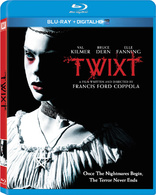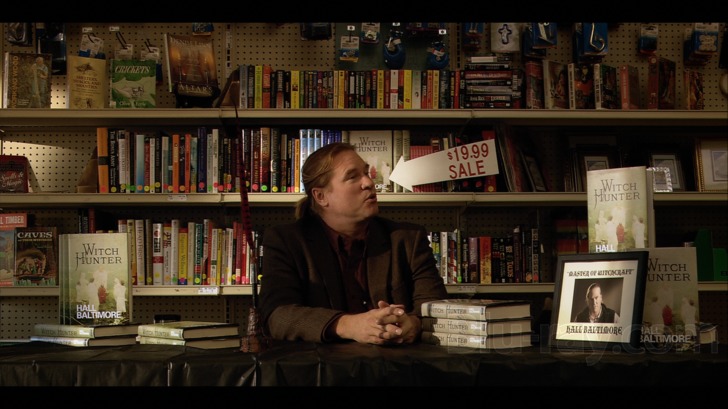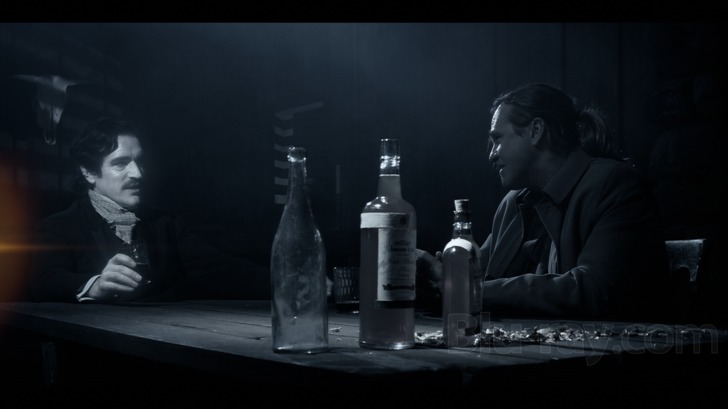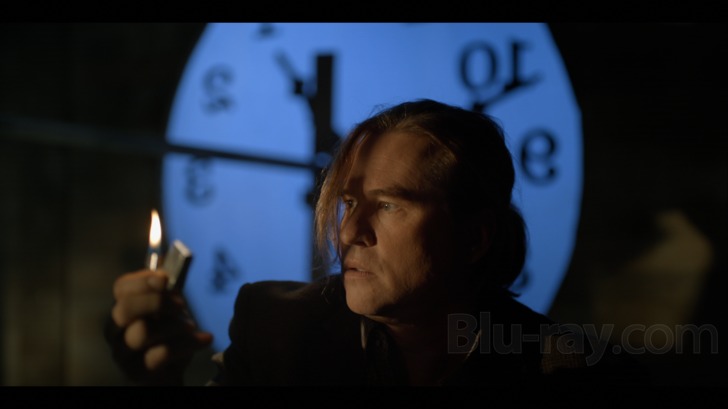Twixt Blu-ray Movie
HomeTwixt Blu-ray Movie 
Blu-ray + UV Digital Copy20th Century Fox | 2011 | 88 min | Not rated | Jul 23, 2013

Movie rating
5.6 | / 10 |
Blu-ray rating
| Users | 0.0 | |
| Reviewer | 2.0 | |
| Overall | 2.0 |
Overview
Twixt (2011)
Writer Hall Baltimore, in career decline, comes to a small town during a book tour, and becomes involved in the murder investigation of a young girl. In a dream, he is approached by a youthful ghost named V, whose connection to the murder is unclear.
Starring: Val Kilmer, Bruce Dern, Elle Fanning, Ben Chaplin, Joanne WhalleyNarrator: Tom Waits
Director: Francis Ford Coppola
| Horror | Uncertain |
| Surreal | Uncertain |
| Thriller | Uncertain |
Specifications
Video
Video codec: MPEG-4 AVC
Video resolution: 1080p
Aspect ratio: 2.00:1
Original aspect ratio: 2.00:1
Audio
English: DTS-HD Master Audio 5.1 (48kHz, 24-bit)
Subtitles
English SDH, French, Spanish
Discs
50GB Blu-ray Disc
Single disc (1 BD)
UV digital copy
Playback
Region A (B, C untested)
Review
Rating summary
| Movie | 1.5 | |
| Video | 3.5 | |
| Audio | 3.5 | |
| Extras | 2.0 | |
| Overall | 2.0 |
Twixt Blu-ray Movie Review
Twixt "awful" and "embarrassing."
Reviewed by Casey Broadwater July 22, 2013Who'd've thought we'd see the day when the once-great Francis Ford Coppola, the New Hollywood icon who brought us The Godfather and
Apocalypse Now, would be reduced to releasing a cringe-worthy straight-to-video horror movie? Twixt, or Twixt Now and
Sunrise—as it was originally titled—was born out of a Poe-like, particularly melancholy dream the filmmaker had a few years ago after a drunken
night in Istanbul, and early reports
of the experimental project were intriguing. After shooting the film in 2010, Coppola devised a way to cut, edit, or otherwise remix the footage in real-
time via an iPad interface, and he planned to take the movie on a 30-city tour—along with star Val Kilmer and composer Dan Deacon—tweaking the
material live in accordance with the mood and reactions of the audience.
This was tentatively praised as a possible answer to "what's next?" in cinema—increasing interaction, a more concert-like atmosphere—but 20th
Century Fox abruptly cancelled the tour for reasons unexplained. Unexplained, yes, but not inexplicable, especially once you've seen the movie here in
its locked
down, definitive form. Twixt is awful. Embarrassingly awful. I can't believe one of the best directors of the '70s made this
awful. The films of Coppola's latter-day career renaissance—Youth Without Youth and Tetro—haven't been great, but they at least feel
like fully-formed works with comprehensible stories. Twixt, though, operates with a sub-David Lynchian dream logic, and worse, it's almost
indescribably tasteless. Not only is it bland—the story has all the excitement of a bowl of oatmeal—but Twixt is more unfortunately tasteless in
the "lacking aesthetic judgement" sense of the word. You know that selective coloring effect overused by amateurish wedding and baby
photographers? The one where they'll desaturate an image to black and white but leave a rose, say, in startlingly gaudy red? Coppola goes nuts with
that trick, giving the impression that he's lost all artistic discernment.

All too fittingly, Twixt is about a once-lauded novelist who's now regarded as less than a hack. Val Kilmer plays Hall Baltimore, a "bargain- basement Stephen King" who drives into the sleepy nowheresville of Swann Valley on his latest book tour, sets up a table in the local hardware shop, and promptly garners an audience of no one. His lone sale comes from the town's cantankerous sheriff, Bobby LaGrange (Big Love's Bruce Dern), who fancies himself a writer and is keen to collaborate with Baltimore. The sheriff even has a story in mind, with a title and all—The Vampire Executions—inspired by the ongoing investigation into the murder of a teenaged girl whose body is still in the police station's morgue, impaled with a wooden stake.
Baltimore agrees to assist, eager to write a book that doesn't involve witches—he's been pigeonholed as the "King of Witchcraft"—and in desperate need of an advance from his publisher in order to keep his shrew of a wife from auctioning off his first-edition, ultra-rare copy of Walt Whitman's Leaves of Grass. After the requisite research, he sets up shop in a fleabag motel, armed with his laptop, a few bottles of Irish whiskey, and several varieties of sleeping pills. See, Baltimore's modus operandi is to literally dream up the endings of his stories, and a good chunk of the film takes place—in selectively colored black and white—inside his sleeping brain. He even has a spirit guide of sorts in the ghostly figure of Edgar Allen Poe (Ben Chaplin), with whom he has unnecessarily longwinded discussions about horror storytelling, the importance of a good refrain—think "Nevermore!"— and the "most melancholy subject in the world," the death of a beautiful young girl.
Intentional or unintentional, the influence of Twin Peaks here is obvious, from the wood-paneled sheriff's office and a derelict, red-curtained hotel—where a dozen children are buried beneath the floorboards—to the all-around kooky townsfolk, like the dancing repairman who's in charge of upkeep on the clock tower that looms over Swann Valley, its seven faces each showing a different time. Coppola strings events and oddities and details together in a way that means to suggest a disjointed Lynchian narrative, but he just doesn't have Lynch's intuition for the haunting and surreal. The story, such as it is, involves a deranged minister (Anthony Fusco), a tribe of goths who party hard in a makeshift Burning Man across the river—led by the Baudelaire-quoting, Harley-riding "Flamingo" (Alden Ehrenreich)—and a spectral 12-year-old named "V" (Elle Fanning), who stands up to one evil and succumbs to another. V appears to Baltimore in his first dream, and becomes a kind of surrogate for his own daughter, who died years before in a tragic boating accident. (Coppola's own son, Gio, was killed in an identical way in 1986.) None of this flows together well, and if there's one thing a film that relies heavily on dream logic needs, it's a good flow.
The sad reality is that Twixt is top-to-bottom bad. The script is leaden with clunky dialogue. The tone is weirdly inconsistent, sometimes straining for a fairytale nightmare vibe and elsewhere going hokey with small-town comedy. Then there's Val Kilmer, looking like an overfed lion and absolutely joyless to watch. (Try not to wince in triplicate when Baltimore—while procrastinating from his writing—does a goofy Brando impersonation, followed by an even goofier James Mason impersonation, followed by a flat-out WTF did I just watch? impersonation of a gay black 1970s basketball player, talking about how much he likes short shorts.) It's hard to even be specific, because everything about the film seems off. Nothing sticks to the wall, so to speak, and what we're left with is a soppy pile of bad ideas and poor stylistic choices. As a "third-rate writer of popular fiction," Hall Baltimore has trouble getting an advance on his new book, and one wonders after Twixt if Francis Ford Coppola will have similar difficulties.
Twixt Blu-ray Movie, Video Quality 

One of Coppola's further experiments in low(er)-budget digital filmmaking, Twixt was shot with a mid-range HD camcorder and then wildly manipulated in post-production. It's hard to judge the film's 1080p/AVC-encoded presentation—framed in the rather unconventional 2.00:1 aspect ratio—by any standards other than its own. Aesthetics are highly subjective—I personally think this is an ugly, tacky film—so I'll try to stick here with what you'll see in the image. Namely, lots of inconsistency. Some scenes are wicked-sharp, with easily visible fine detail in faces and clothing, while others are gauzy and soft, with noticeably indistinct textures. Likewise, some night scenes are buzzing with source noise, while others have clearly been smoothed out with some manner of digital noise reduction. We can presume that, color-wise, the film probably looks as intended, but the grading is harsh and intentionally stylized, with lots of day-for-night digital conversions, selective coloring, and amped up or flattened contrast. It is what it is, and the best I can say is that the Blu-ray release is definitely a truer-to-source-and-intent version of the film than the DVD.
Twixt Blu-ray Movie, Audio Quality 

The film features a lossless DTS-HD Master Audio 5.1 surround track that's somewhere twixt "acceptable" and "excellent." That is, this is a workmanlike mix that gets the job done and rarely draws any attention to itself. Projection is good from the front speakers, and the rears pipe up often for quiet ambience—town sounds, wind, sirens, a tolling bell—along with offering some bleeding room for the witchy musical cues of Baltimore-based electro- wizard Dan Deacon. Dialogue is clear and consistently balanced, and there are no major sound quality issues to report. The disc includes optional English SDH and Spanish subtitles.
Twixt Blu-ray Movie, Special Features and Extras 

- Twixt - A Documentary by Gia Coppola (HD, 37:42): Coppola's granddaughter pieced together this making-of doc out of footage she shot on set, but it's about as watchable as the film itself.
- Sneak Peek (HD, 12:16)
Twixt Blu-ray Movie, Overall Score and Recommendation 

New York Observer critic Rex Reed wrote of Youth Without Youth, "The only way to survive [it] is dead drunk. The least Mr. Coppola could do is provide free Cabernet Sauvignon from his own vineyards. One bottle going in, another bottle staggering out." It was maybe an unfair assessment of Coppola's 2007 drama—which is at the very least watchable—but it could certainly apply to Twixt, which is soon to appear on every list of worst films by the best directors. It's an irredeemable movie, and nothing says more than 20th Century Fox's decision to nix Coppola's planned 30-city theatrical tour and instead shuffle the film out onto video, with no fanfare, two years after it was made. At best, it's worth watching as a curiosity, a failed experiment by the man who was once the high hope of American moviemaking.
Similar titles
Similar titles you might also like

Housebound
2014

The Autopsy of Jane Doe
2016

Dementia 13
Director's Cut
1963

Jackals
2016

Scream 4
Scre4m
2011

The Haunting in Connecticut 2: Ghosts of Georgia
2013

House on Haunted Hill 3D
1959

Gothika
2003

Fright Night 2: New Blood
2013

The Comeback
1978

Marrowbone
The Secret of Marrowbone
2017

Halloween II
Unrated Director's Cut
2009

Pale Blood
Standard Edition
1990

The Void
2016

Doctor X
Warner Archive Collection
1932

Incubus
1982

Bound to Vengeance
2014

Silent Night, Bloody Night
Night of the Dark Full Moon / Death House
1972

Curse of Chucky 4K
Collector's Edition
2013

Texas Chainsaw Massacre
2022
